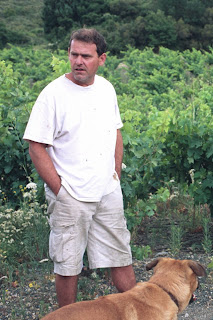I usually enjoy myself talking about one of my favourite and most well-travelled chunks of the Languedoc - that gigantic windswept and ruggedly picturesque corner stretching from the Corbières hills themselves north of the Roussillon up to Narbonne and almost across to the gates of Carcassonne to the west. Nowadays, this region is a good place to look for great-value easy going reds, whites and rosés; as well as some of the Languedoc's best estates and co-op wineries. Mind you, there's still quite a bit of dross lurking around too but much less than in the past I'd say. Red and rosé wines are based largely on Carignan, Syrah, Grenache, Cinsault and Mourvèdre with some Lladoner pelut (the Roussillon/Catalan variety related or similar to Grenache) and the somewhat rarer Piquepoul noir or Terret noir even.
I've gone on about Boutenac several times before (see links at the bottom and wineries there listed in the A to Z in the right-hand column), one of the new subzones centered on that eponymous blink-and-miss-it village, which is still finding its feet although already capable of nurturing a good handful of top red wines. At a mammoth tasting in the South a few months ago (the annual "Millésimes en Languedoc" gig), I focused my tasting buds on this area and have also picked a few tantalizing white Corbières wines. However, a number of the 2009 Boutenac reds had rather heavy drying tannins and/or too much oak, which seems to be increasingly obvious with many reds in general from this hot vintage. But the 2010s and 2011s on show appeared to offer greater promise. The whites are created from these varieties: Bourboulenc (confusingly known locally as Malvoisie), Grenache blanc, Maccabeu, Clairette, Muscat, Piquepoul, Terret blanc, Marsanne, Roussanne and Rolle (aka Vermentino). Further generic info @ 20decorbieres.com. So: 1, 2, 3, over to the tasting-note-tastic bit:
Boutenac all reds
2009 vintage
Château Ollieux Romanis Atal Sia - quirky 'cheesy' tones tinged with fragrant ripe blueberry, solid dry palate vs a touch of silkiness too, quite extracted but it works with that elusive aromatic fruit. Good to very good.
Gérard Bertrand La Forge - showing a fair bit of coconut oak still but layered with attractive 'sweet' aromatic fruit, grainy coco texture, tight and quite fine, those tannins do round out in the end. Good to very good.
2010
Château de Caraguilhes Solus (mostly Mourvèdre/Syrah) - rich dark smoky nose, concentrated black cherry / olive, firm but well-textured tannins; bit of chocolate oak underpinned by lush dark fruit, punchy finish vs good substance. Very good towards fab.
Gérard Bertrand Domaine de Villemajou - perfumed floral berry and cherry notes, quite chunky and firm vs 'sweet' berry fruit, again powerful and tight vs nice vibrant fruit. Very good.
Gérard Bertrand Château Aigues Vives - similar but with (more) oak, adding grain and texture, has 'sweet' fruit underneath with tight grippy finish. Good.
2011 (mostly unfinished samples)
Gérard Bertrand Domaine de Villemajou - aromatic and rich, blueberry cassis and black cherry, chunky vs concentrated palate, lovely dark fruit and spice with firm yet rounded finish. Very promising.
Villemajou Grand Vin - touches of coconut oak, grippier yet more intense than above with underlying concentrated dark berry fruit, tight firm and punchy finish. Also promising.
Villemajou La Forge - closed nose, moving on to vibrant black fruity palate, peppery and powerful with solid structure, lush substance with lovely textured tannins, closes up again. Lovely wine, should really blossom.
Gérard Bertrand Château Aigues Vives - nice black cherry/berry fruit, fairly rich vs grippy mouth-feel, again those tannins are already quite rounded, has a touch of freshness about it too. Very good.
Celliers d'Orfée - aromatic floral wild herb and mint nose layered with blueberry and damson fruit, firm vs supple palate, shows nice balance and style. Very good.Vignerons de Cascastel - juicy fruit with light oak vs honeyed roundness, nice enough wine.
Bonfils - quite full and honeyed vs crisp and mineral finish. Good.
Meunier Saint-Louis Prestige - attractive lightly honeyed and creamy side vs citrus and pear, juicy lees-y palate vs crisp and dry finish. Good stuff.
Etang tradition - crisp and steely, light yeast-lees tones with dry bite and tight finish. Good.
Prieuré Carminal - rounder and juicier wine, nice floral and honeyed character vs celery mineral bite, quite concentrated and tasty too. Good stuff.
Bastide tradition - enticing honeysuckle and more exotic fruit, oily vs crisp mouth-feel, shows fair depth and weight too with 'chalkier' finish. Very good.
Gérard Bertrand Villemajou - nice mix of creamy lees-y notes vs white peppery vs oily exotic fruit/texture, zingier pear too vs a touch of toasted oak and concentrated finish. Very good.
Some other recent stuff on Corbières:



